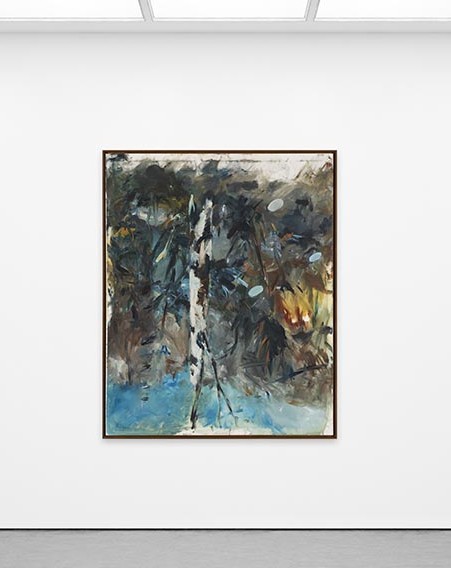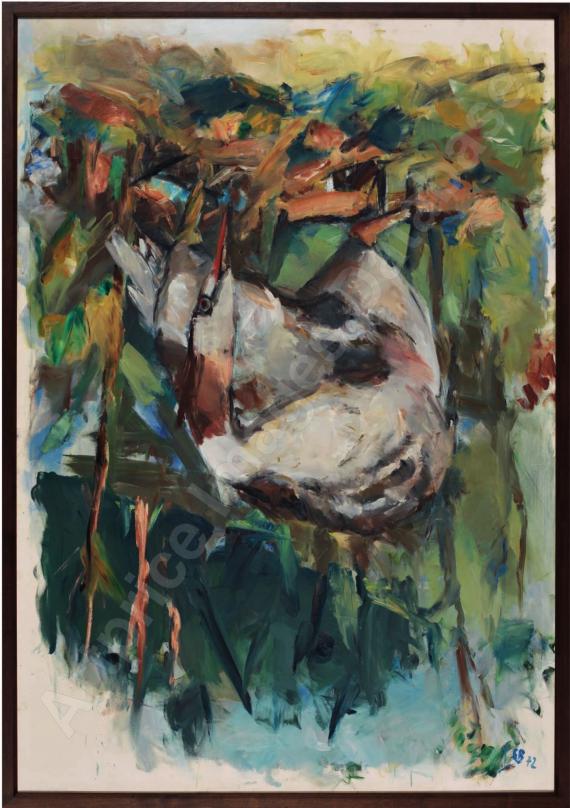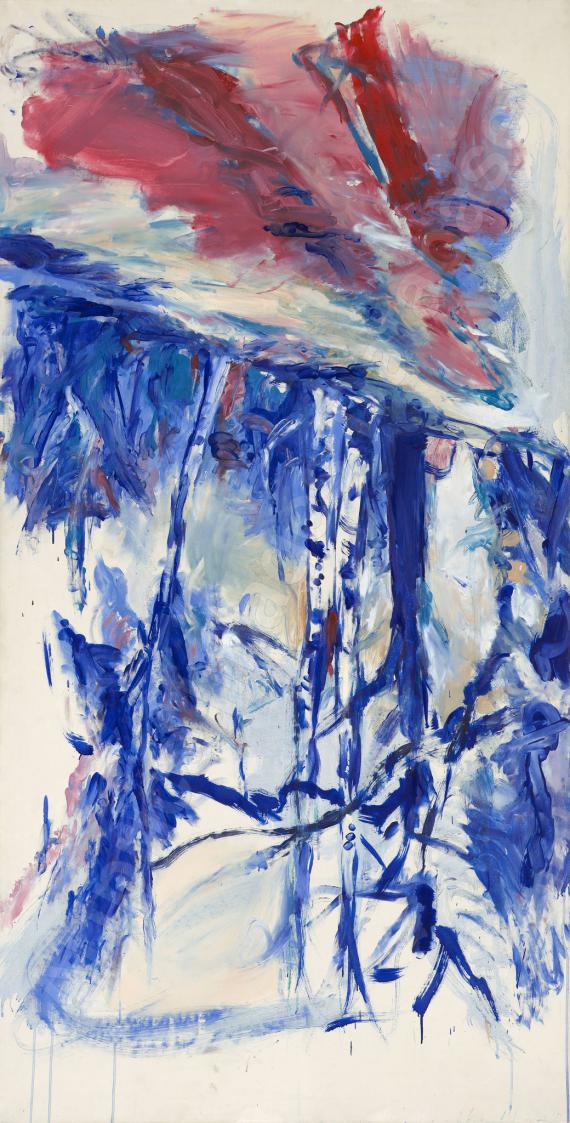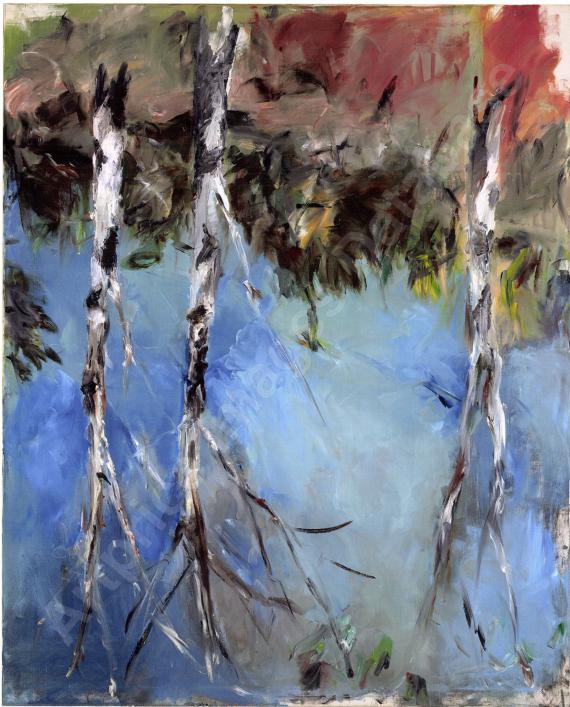124000236
Georg Baselitz
Fingermalerei - Birke, 1972.
Olio su tela
Stima: € 800,000 / $ 856,000
Le informationi sulla commissione, le tasse e il diritto di seguito saranno disponibili quattro settimane prima dell´asta.
Fingermalerei - Birke. 1972.
Oil on canvas.
Lower left signed and dated. Dated and titled "Fingermalerei-Birke" on the reverse. Signed, dated and titled on the folded canvas. 162 x 130 cm (63.7 x 51.1 in). [JS].
• One of the first Baselitz paintings with the characteristic upside-down motif.
• With "Der Wald auf dem Kopf", today at the Museum Ludwig in Cologne, Georg Baselitz painted his first upside-down figurative motif in 1969.
• Baselitz was represented at documenta 5 with a work from this important series the year our work was created.
• Works from both this seminal creative phase and the "Finger Paintings" series are extremely rare on the international auction market and fetch top prices.
• Comparable works can be found in important collections like the Pinakothek der Moderne/Museum Brandhorst, Munich, the Museum of Modern Art, New York, the Museum Folkwang, Essen and the San Francisco Museum of Modern Art.
• Most recently, the Centre Pompidou, Paris, honored Baselitz's work with a major exhibition entitled "Georg Baselitz. La rétrospective" (2021/22).
PROVENANCE: Galerie Neuendorf, Hamburg (directly from the artist).
Jürgen Holstein Antiquariat, Pöcking.
Private collection North Rhine-Westphalia.
Private collection Northern Germany (inherited from the above in 2013).
Oil on canvas.
Lower left signed and dated. Dated and titled "Fingermalerei-Birke" on the reverse. Signed, dated and titled on the folded canvas. 162 x 130 cm (63.7 x 51.1 in). [JS].
• One of the first Baselitz paintings with the characteristic upside-down motif.
• With "Der Wald auf dem Kopf", today at the Museum Ludwig in Cologne, Georg Baselitz painted his first upside-down figurative motif in 1969.
• Baselitz was represented at documenta 5 with a work from this important series the year our work was created.
• Works from both this seminal creative phase and the "Finger Paintings" series are extremely rare on the international auction market and fetch top prices.
• Comparable works can be found in important collections like the Pinakothek der Moderne/Museum Brandhorst, Munich, the Museum of Modern Art, New York, the Museum Folkwang, Essen and the San Francisco Museum of Modern Art.
• Most recently, the Centre Pompidou, Paris, honored Baselitz's work with a major exhibition entitled "Georg Baselitz. La rétrospective" (2021/22).
PROVENANCE: Galerie Neuendorf, Hamburg (directly from the artist).
Jürgen Holstein Antiquariat, Pöcking.
Private collection North Rhine-Westphalia.
Private collection Northern Germany (inherited from the above in 2013).
An eventful German biography
Georg Baselitz is considered one of the most important artists of contemporary German art. His works, with their different approaches and motifs, are characerized by a gestural expressive figuration and demonstrate his considerable versatility. Georg Baselitz was born the year before the Second World War broke out and grew up in the aftermath of the horrific events of the war. He initially studied painting in East Berlin, in 1957 he transferred to the 'Hochschule der Bildenden Künste' in Berlin-Charlottenburg, where Hann Trier was one of his teachers. He became a citizen of West Germany in 1958 and was denied access to his old homeland as a result of the construction of the Berlin Wall in 1961. An eventful German biography.
The motif. The forest
In 1971, the artist moved to Forst an der Weinstraße, before he eventually moved to Derneburg in 1975. Baselitz continued on a path of experimentation and a quest for ways to express his characteristic motifs in form, color and surface using a variety of techniques that, in terms of creating art, did not stand in the way of either the subject or the painting method. In a new studio surrounded by nature, he produced his first Finger Paintings. Increasing the distance to the subject was accompanied by a physical approximation of the painting. Baselitz dipped his hands into the paint bucket and created the image directly on the canvas using his fingers. There should be nothing between him and the painting, not even the brush. In the years that followed, this effect resulted in outstanding works with an unprecedented character, among them "Fingermalerei I - Adler" (1971/72), "Akt Elke" (1974) and the furiously painted "Waldweg", a vivid yet fragmentary motif without a concrete narrative or content.
Attacking the illusion of painting
Baselitz's upside-down paintings show a radical rejection of the mimesis of Western painting, of the conventions of painting, which go back to the rules of perspective established in the Renaissance. The illusion that the observer of a painting sees an exact image of the world was maintained until the late 19th century, when photography replaced painted magic with a more convincing image of the real world. Since this time, painters have illusionized what they see, developing painting styles such as Impressionism, losing themselves in the theory of Pointillism and evolving into Expressionism and New Objectivity, finally trying their hand at the broad field of non-objectivity. And yet, like many painters of the 20th century, Baselitz sought a way to break with tradition, to paint pictures without sacrificing the appearance of reality. And Baselitz convinces viewers to accept his upside-down world as a new pictorial convention. The "upside-down" painting is accompanied by the effect of eliminating the meaning of the figure, liberating the motif from a certain gravity. After this "pivot" in 1969, Baselitz painted a series of inverted portraits, followed by pictures within the picture, in which one picture - usually a landscape - is framed by another, thus extending the break with conventional painting.
Inverting established patterns
When Georg Baselitz made "Der Wald auf dem Kopf" in 1969, the first work with the motif rotated by 180 degrees, it was widely understood as an artistic provocation. (Fig.) There is no doubt that it was not only his intention to question the act of painting itself, but also to challenge traditional viewing habits, however, provocation as an end in itself was far from the artist's mind, as he took painting far too seriously. Baselitz later said that he had reached a point at which he wanted to change the direction of his painting. As early as 1964, he experimented by turning motifs upside down, as can be seen in the painting "Das Kreuz" (The Cross), in which Baselitz turns the row of houses upside down. And in 1968, he tied a forest worker headfirst to a tree in the painting of the same name, surely a reminiscence of the martyrdom of the Apostle Peter and Christian motifs from Renaissance. In the following year, as mentioned above, he painted "Der Wald auf dem Kopf", the first composition with the motif completely upside down. The artist was probably inspired by the painting " Wermsdorfer Wald" by Ferdinand von Rayski (1806-1890) from 1859, which he had seen at the Gemäldegalerie Neue Meister in Dresden. (Fig.) And with this reversal in the picture, Baselitz ultimately combined a deeply Nordic Romanticism with the impulsiveness of German Expressionism, both in terms of art history and painting style. On the one hand, Rayski's forests represent a naturalistic painting tradition dating back to the 19th century; on the other hand, Rayski's Saxon landscapes represent childhood places that had become inaccessible for Baselitz after his move to West Berlin and the construction of the Berlin Wall in 1961. Caspar David Friedrich's painting provided Baselitz with a further important guideline. Friedrich constructed landscapes and idealized the real situation: "A landscape is a state of mind. Men should not only paint what they see before them, but also what they see within themselves". This radical new way of thinking played a decisive role for Baselitz, for whom it was all about the landscape in his memory - the reason for a lifelong confrontation. Nordic people in particular are said to have a deep connection with the forest. The forest as a place of longing, a place of silence, retreat and strength is praised in songs, poems and pictures. To a greater extent, Romanticism shaped this connection to the forest, particularly in terms of German identity. In his work, Georg Baselitz has not only dealt intensively with German history, the question of identity and his own biography, but also integrated the legacy of art history into his pictorial thinking. [MvL]
Georg Baselitz is considered one of the most important artists of contemporary German art. His works, with their different approaches and motifs, are characerized by a gestural expressive figuration and demonstrate his considerable versatility. Georg Baselitz was born the year before the Second World War broke out and grew up in the aftermath of the horrific events of the war. He initially studied painting in East Berlin, in 1957 he transferred to the 'Hochschule der Bildenden Künste' in Berlin-Charlottenburg, where Hann Trier was one of his teachers. He became a citizen of West Germany in 1958 and was denied access to his old homeland as a result of the construction of the Berlin Wall in 1961. An eventful German biography.
The motif. The forest
In 1971, the artist moved to Forst an der Weinstraße, before he eventually moved to Derneburg in 1975. Baselitz continued on a path of experimentation and a quest for ways to express his characteristic motifs in form, color and surface using a variety of techniques that, in terms of creating art, did not stand in the way of either the subject or the painting method. In a new studio surrounded by nature, he produced his first Finger Paintings. Increasing the distance to the subject was accompanied by a physical approximation of the painting. Baselitz dipped his hands into the paint bucket and created the image directly on the canvas using his fingers. There should be nothing between him and the painting, not even the brush. In the years that followed, this effect resulted in outstanding works with an unprecedented character, among them "Fingermalerei I - Adler" (1971/72), "Akt Elke" (1974) and the furiously painted "Waldweg", a vivid yet fragmentary motif without a concrete narrative or content.
Attacking the illusion of painting
Baselitz's upside-down paintings show a radical rejection of the mimesis of Western painting, of the conventions of painting, which go back to the rules of perspective established in the Renaissance. The illusion that the observer of a painting sees an exact image of the world was maintained until the late 19th century, when photography replaced painted magic with a more convincing image of the real world. Since this time, painters have illusionized what they see, developing painting styles such as Impressionism, losing themselves in the theory of Pointillism and evolving into Expressionism and New Objectivity, finally trying their hand at the broad field of non-objectivity. And yet, like many painters of the 20th century, Baselitz sought a way to break with tradition, to paint pictures without sacrificing the appearance of reality. And Baselitz convinces viewers to accept his upside-down world as a new pictorial convention. The "upside-down" painting is accompanied by the effect of eliminating the meaning of the figure, liberating the motif from a certain gravity. After this "pivot" in 1969, Baselitz painted a series of inverted portraits, followed by pictures within the picture, in which one picture - usually a landscape - is framed by another, thus extending the break with conventional painting.
Inverting established patterns
When Georg Baselitz made "Der Wald auf dem Kopf" in 1969, the first work with the motif rotated by 180 degrees, it was widely understood as an artistic provocation. (Fig.) There is no doubt that it was not only his intention to question the act of painting itself, but also to challenge traditional viewing habits, however, provocation as an end in itself was far from the artist's mind, as he took painting far too seriously. Baselitz later said that he had reached a point at which he wanted to change the direction of his painting. As early as 1964, he experimented by turning motifs upside down, as can be seen in the painting "Das Kreuz" (The Cross), in which Baselitz turns the row of houses upside down. And in 1968, he tied a forest worker headfirst to a tree in the painting of the same name, surely a reminiscence of the martyrdom of the Apostle Peter and Christian motifs from Renaissance. In the following year, as mentioned above, he painted "Der Wald auf dem Kopf", the first composition with the motif completely upside down. The artist was probably inspired by the painting " Wermsdorfer Wald" by Ferdinand von Rayski (1806-1890) from 1859, which he had seen at the Gemäldegalerie Neue Meister in Dresden. (Fig.) And with this reversal in the picture, Baselitz ultimately combined a deeply Nordic Romanticism with the impulsiveness of German Expressionism, both in terms of art history and painting style. On the one hand, Rayski's forests represent a naturalistic painting tradition dating back to the 19th century; on the other hand, Rayski's Saxon landscapes represent childhood places that had become inaccessible for Baselitz after his move to West Berlin and the construction of the Berlin Wall in 1961. Caspar David Friedrich's painting provided Baselitz with a further important guideline. Friedrich constructed landscapes and idealized the real situation: "A landscape is a state of mind. Men should not only paint what they see before them, but also what they see within themselves". This radical new way of thinking played a decisive role for Baselitz, for whom it was all about the landscape in his memory - the reason for a lifelong confrontation. Nordic people in particular are said to have a deep connection with the forest. The forest as a place of longing, a place of silence, retreat and strength is praised in songs, poems and pictures. To a greater extent, Romanticism shaped this connection to the forest, particularly in terms of German identity. In his work, Georg Baselitz has not only dealt intensively with German history, the question of identity and his own biography, but also integrated the legacy of art history into his pictorial thinking. [MvL]
124000236
Georg Baselitz
Fingermalerei - Birke, 1972.
Olio su tela
Stima: € 800,000 / $ 856,000
Le informationi sulla commissione, le tasse e il diritto di seguito saranno disponibili quattro settimane prima dell´asta.




 Lot 124000236
Lot 124000236 


